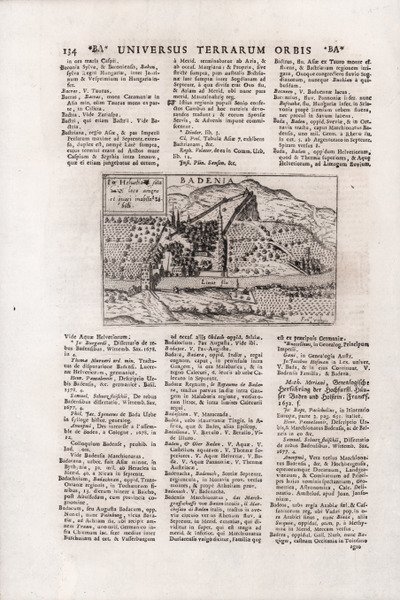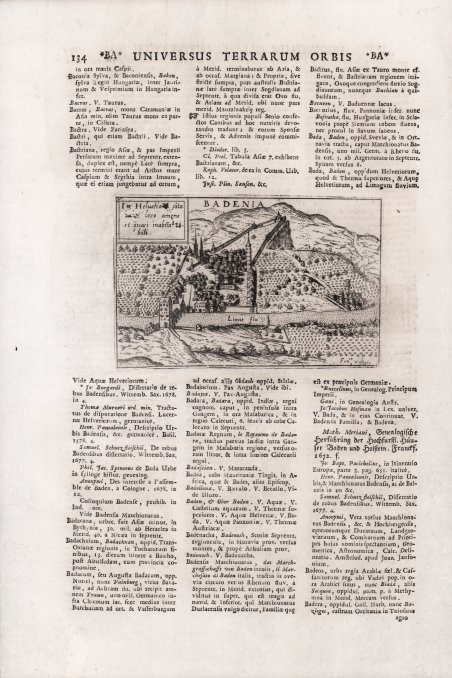Veduta pubblicata per la prima volta nella serie ' La Raccolta di le piu illustri et famose citta di tutto il mondo, edita da Francesco Valegio a Venezia verso la fine del ’500, che comprende circa 322 piante e vedute delle principali città del mondo conosciuto. Di questo volume, si conservano diversi esemplari, tutti con numero variabile di incisioni e privi di un indice a stampa. Inoltre, gran parte delle tavole contenute nella raccolta del Valegio furono inserite nella ' Nuova raccolta di tutte le più illustri et famose città di tutto il mondo, curata da Donato Rasciotti, edita alla fine del sedicesimo secolo. Tuttavia, è persino incerto quale delle due raccolte venne per prima alla luce ed ignote sono le datazioni di tutte le tirature conosciute. Francesco Valegio nasce a Bologna circa nel 1560, anche se alcuni studiosi gli accreditano un’origine veronese; la sua attività di incisore ed editore calcografo si svolge tutta a Venezia, spesso in associazione con altri stampatori. Le tavole che compaiono nelle ' Raccolta, che senza dubbio possiamo considerare come la sua opera più importante, sono tutte prive di data, ad eccezione di quelle di Algeri, Costantinopoli e Rodi, firmate da Martino Rota, datate 1572. Le piante e le vedute firmate dal Rota, incisore nativo di Sebenico e attivo a Venezia fino al 1573, costituiscono, senza dubbio, il nucleo più antico dell’opera e fanno ritenere che questa sia stata un progetto editoriale iniziato proprio dall’incisore dalmata. In un primo momento, la presenza di queste tavole aveva portato a datare l’opera al 1579, data che sembra tuttavia molto improbabile. Molte delle immagini riprendono modelli figurativi apparsi nei primi volumi del ' Civitates Orbis Terrarum, editi tra il 1572 ed il 1588 (e successivamente ristampati sino al 1617) dai cartografi Georg Braun e Franz Hogenberg. Pertanto, è molto più plausibile che il Valegio iniziò verso il 1580 ad osservare le tavole incise da Martino Rota, per poi ampliare e pubblicare la raccolta, nell’ultimo ventennio del secolo. Dell’intero corpus di incisioni che compongono l’opera, 112 recano la firma o la sigla del Valegio, altrettante sono assimilabili alla mano dello stesso, mentre 69 sono ascrivibili ad altro artista, non identificato. Questo esemplare è tratto dall'opera ' Universus terrarum orbis scriptorum calamo delineatus . qui de Europae, Asiae, Africae, & Americae regnis, provinciis, populis, civitatibus. pubblicata a Padova nel 1713, presso Matteo Cadorin, da Raffaello Savonarola, sotto lo pseudonimo di Lasor a Varea (o Varela). L'opera era una sorta di enciclopedia che conteneva notizie sulle varie località del mondo disposte in ordine alfabetico, arricchita da mappe e vedute di tutto il mondo che appartengono a celebri raccolte cartografiche del passato – Bertelli, Valegio, Camocio, Bonifacio, Nelli, Magini e altri – del quale probabilmente l’editore Cadorin era in possesso delle matrici originali. Incisione su rame, ampi margini, in ottimo stato di conservazione. La Raccolta di le piu illustri et famose citta di tutto il mondo, published by Francesco Valegio in Venice towards the end of the XVI century, containing about 322 plans and views of the main cities of the World. There are different examples of this work, every one with a different number of plates and without an index. Many of these plates have been afterwards included in Donato Rasciotti's ' Nuova raccolta di tutte le più illustri et famose città di tutto il mondo, ' printed at the end of the XVI century. It is still, however, quite unclear whether Valegio or Rasciotti published first his collection. Francesco Valegio was born in Bologna around 1560, even though some say he might have been born in Verona; as engraver and calcographer, he worked in Venice, very often in association with other publishers. The plates of his series, which can be considered his most important work, do not bear any date, except for those of Algeri, Costantinopoli and Rodi, signed by Martino Rota, dated 1572. The city plans signed by Rota, (engraver born in Sebenico who worked in Venice until 1573), are the most ancient core of the work, which make us think that this work has been planned by Rota himself. Many plates recall the figurative models of the ' Civitates Orbis Terrarum ' printed between 1572 and 1588 (afterwards reissued until 1617) by Georg Braun and Franz Hogenberg. It is possible that Valegio started to select the plates by Rota around 1580 and afterwards enlarged his collection at the end of the century. 112 plates bear Valegio's signature or monogram and as many can be ascribed to him; 69 have been ascribed to an unkwown artist. The collection was extremely successful and became the base for the following copies. ' This example is taken from the work ' Universus terrarum orbis scriptorum calamo delineatus . qui de Europae, Asiae, Africae, & Americae regnis, provinciis, populis, civitatibus. ' published in Padua in 1713, at Matteo Cadorin, by Raffaello Savonarola, under the pseudonym of Lasor a Varea (or Varela). The work was a kind of encyclopedia containing news about the various localities of the world arranged in alphabetical order, enriched with maps and views of the whole world belonging to famous cartographic collections of the past-Bertelli, Valegio, Camocio, Bonifacio, Nelli, Magini, and others-of which the publisher Cadorin probably possessed the original plates. Copper engraving, in excellent condition. ' Very rare. Cfr.


Find out how to use
Find out how to use

